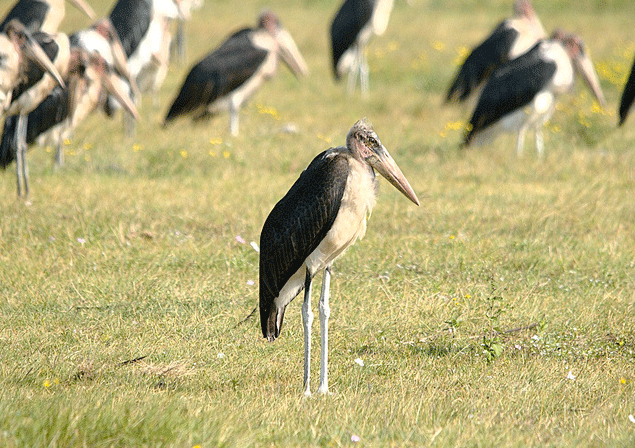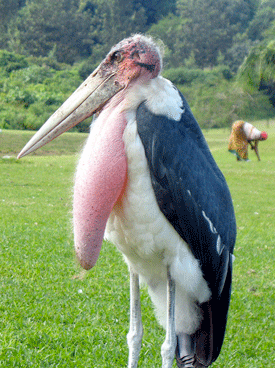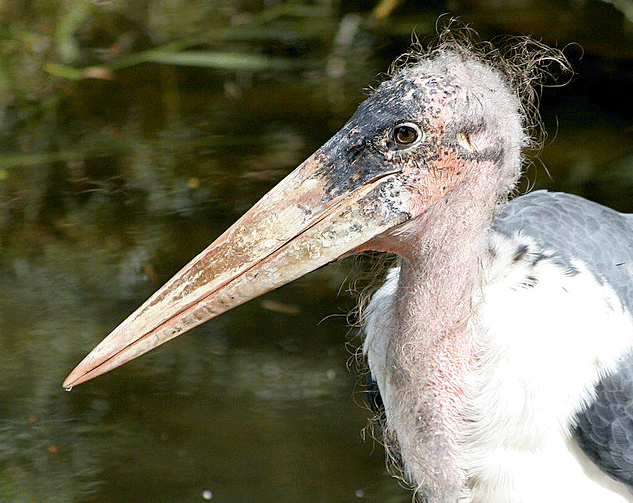Marabou Stork
Air Date: Week of September 21, 2012

A flock of Marabou Storks (Photo: Sergey Yeliseev)
Marabou Storks are large graceful birds, but Ugandans in Kampala see them as a menace. Uncollected garbage and slaughter-house refuse have led to a stork population explosion. Ari Daniel Shapiro reports that Ugandans are turning to desperate measures to get rid of the birds.
Transcript
CURWOOD: Urban and natural landscapes rub against each other the world over. Often, they leak into each other. And when they do, natural places get sliced up and thinned out and cities get overrun by the unwanted. Reporter Ari Daniel Shapiro has a story from Uganda about a particularly pesky bird -- though exactly how pesky depends on whom you ask.
SHAPIRO: Before I get into why a lot of people in Uganda despise Leptoptilos crumeniferus, or the Marabou stork…I need to tell you what these birds look like. I’m at Makerere University, in Kampala. Lilian Twanza is a graduate student here, and she studied the Marabou storks as an undergrad. Twanza points to the sky.
TWANZA: Wait, can you see them?
SHAPIRO: Oh, yeah, they’re all up there. Look at that. There must be 20 birds up there!
SHAPIRO: Even from a distance, they’re huge. Wingspans of up to 9 or 10 feet. They’re dark and graceful. But up close is a different matter.
TWANZA: Someone once said they have the typical look of a dirty old man.

Marabou Stork (Photo: kibuyu)
SHAPIRO: Indeed. Twanza’s brought me to within spitting distance of several Marabous. They’re sitting above us, in the branches of an albizia tree on the edge of a campus parking lot.
The storks are bald. The head and neck are pinkish without feathers. Long pouches droop beneath their necks like fleshy tube socks. A bright red bump swells from the nape. The rest of the bird is covered in black and white feathers. And beneath one of the storks in the tree – a couple of fuzzy white heads.
TWANZA: Just two heads down there. When it gets very hot, the adult stretches out its wings, just providing shade for the young one. You can’t tell whether it’s the male or female. They both parent in turns.
SHAPRIO: The adult coos at the babies. And the babies coo right back.
[SOUNDS OF COO-ING MARABOU STORKS]
TWANZA: Marabous are monogamous. They pair once for life.
SHAPIRO: For life?
TWANZA: Yes.
SHAPIRO: Physical appearances aside, this portrait of Marabou family dynamics might seem rather lovely. But I haven’t said what these storks feed on. They’re scavengers. In the wild, the storks gobble up carcass scraps, and feces. That’s why they’re bald – otherwise the head feathers would get clotted up with blood and grime. They also eat small, live animals.
TWANZA: Fish, rats, snakes, frogs.
SHAPRIO: But in a big city like Kampala, the Marabous have a lot more to choose from.
TWANZA: Mainly what attracts them is garbage. In Africa, garbage collection is not good so the garbage stays lying around.
SHAPRIO: Along with all the garbage, Kampala has three abattoirs, or slaughterhouses, and the fleshy scraps get chucked out the back. The storks wolf those down too and either regurgitate them for their young or carry the pieces back whole. All this food means more of the baby birds are surviving into adulthood. The result is a population explosion.
They’re one of the first things I saw after arriving at the airport. They sit atop the poles lining the highways. They circle the air above the city. And when they do settle down, into a tree above a parking lot, say, that’s when the real mischief starts. The ground beneath our feet is splattered with white.

(Photo: M Kuhn)
TWANZA: Those are the droppings. It’s a bit acidic.
SHAPIRO: When the droppings land on a car, it dissolves the paint right off.
TWANZA: So if you keep leaving your car under the shade, wanting protect it from the sun, the Marabous will spoil it. And then when people are passing, it can drop on you also – on your clothes, in your hair.
SHAPIRO: The droppings corrode rooftops and trees. The birds even end up targeting themselves.
TWANZA: The legs of the Marabou stork are not characteristically white. That’s a coating of their own droppings.
SHAPIRO: Twanza says that Ugandans are beyond frustrated with these storks. They’ve taken matters into their own hands.
TWANZA: If you had been here maybe, like, on Monday, you would have seen the tree that had been cut and the young had fallen down and died there.
SHAPIRO: Why did they cut the tree?
TWANZA: Usually they use another excuse so that the environment people don’t come, complaining a lot. They say, “We cut the branches because of the electric wires.” But generally, they want to get rid of the storks.
SHAPIRO: Once a baby stork’s fallen to the ground, the parents stop taking care of it.
TWANZA: The young ones, some of them just get broken limbs so they stay there and die from hunger or other animals destroying them.
SHAPIRO: It doesn’t fix the problem, though. The following year, the Marabou pair will breed again and hatch another two or three chicks. Twanza has a different solution.
TWANZA: The only recommendation is getting rid of garbage.
SHAPIRO: Less food means fewer young survive. Gradually, the Marabou numbers will decline. Twanza’s seen it happen on campus. When she first started studying Marabou storks in 2008, she counted 5000 storks filling up the trees and rooftops of the university. Now, after a few years of improved, daily, trash collection, the numbers are down to 2000.
But Twanza isn’t expecting similar improvements in sanitation throughout Kampala. And yet, at the same time, she recognizes that the birds are important, and even good for Uganda.
TWANZA: They get rid of everything we don’t want. We want them alive – they are part of the ecosystem.
SHAPIRO: Marabou storks exist alongside an ecology that humans have created, just like cockroaches or rats. People tend not to like those animals either. But actually – all those storks sitting in the trees, or the rats scurrying down an alley – they’re really just an indication of our own habits. Habits that could use some cleaning up.
For Living on Earth, I’m Ari Daniel Shapiro.
CURWOOD: Our story on Marabou Storks comes from the series One Species at a Time, produced by Atlantic Public Media with support from The Encyclopedia of Life. For photos - check out our web site - loe.org.
Living on Earth wants to hear from you!
Living on Earth
62 Calef Highway, Suite 212
Lee, NH 03861
Telephone: 617-287-4121
E-mail: comments@loe.org
Newsletter [Click here]
Donate to Living on Earth!
Living on Earth is an independent media program and relies entirely on contributions from listeners and institutions supporting public service. Please donate now to preserve an independent environmental voice.
NewsletterLiving on Earth offers a weekly delivery of the show's rundown to your mailbox. Sign up for our newsletter today!
 Sailors For The Sea: Be the change you want to sea.
Sailors For The Sea: Be the change you want to sea.
 The Grantham Foundation for the Protection of the Environment: Committed to protecting and improving the health of the global environment.
The Grantham Foundation for the Protection of the Environment: Committed to protecting and improving the health of the global environment.
 Contribute to Living on Earth and receive, as our gift to you, an archival print of one of Mark Seth Lender's extraordinary wildlife photographs. Follow the link to see Mark's current collection of photographs.
Contribute to Living on Earth and receive, as our gift to you, an archival print of one of Mark Seth Lender's extraordinary wildlife photographs. Follow the link to see Mark's current collection of photographs.
 Buy a signed copy of Mark Seth Lender's book Smeagull the Seagull & support Living on Earth
Buy a signed copy of Mark Seth Lender's book Smeagull the Seagull & support Living on Earth

